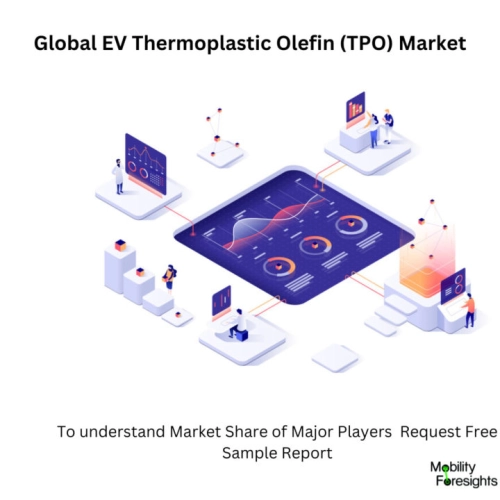
- Get in Touch with Us

Last Updated: Apr 25, 2025 | Study Period: 2023-2030
A thermoplastic olefin is a chemical compound made of rubber, high molecular weight polyethylene, and a filler that provides reinforcement. The great corrosion resistance of thermoplastic olefins, which makes them suited for use in corrosion prevention, is a result of this composition. They are frequently employed in this role as liners and coatings.
The liners of thermoplastic olefins are frequently made of talc, carbon fiber, or calcium carbonate. This produces a very resilient thermoplastic that is versatile for a variety of paints and finishes and scratch, UV, and impact resistant.
Thermoplastic olefins are ideally suited for harsh chemical conditions and outdoor use because they have the following advantageous characteristics.
High molecular weight polyethylene (HMWPE) or polypropylene (PP), rubber, and a reinforcing filler often calcium carbonate, carbon fibre, or talc makeup thermoplastic olefin.
This combination of components produces a strong, extremely durable thermoplastic that can be tailored with better impact and scratch resistance as well as all kinds of paint and finishes.
It is perfect for outdoor use because it is also very resistant to solar UV radiation and temperature extremes.
The process of thermoplastic olefin thermoforming involves wrapping heated sheets of TPO around a specially made tool and applying force from outside to press the plastic against the tool to produce the required shape.
A single-ply roof membrane constructed of ethylene propylene rubber makes up a thermoplastic olefin (TPO) roof. These membranes are designed to combine the remarkable performance of hot-air sealable closures with the durability of EPDM rubber.
TPO membranes have established themselves as dependable roofing materials with outstanding ozone resistance. They are also environmentally friendly and resistant to algae.
These roof membranes' widespread use today is also attributed to how simple and secure they are to install. To understand more about TPO roofing, keep reading.
The affordability of TPO roofing is one of the key factors influencing property developers to choose it over alternative solutions. TPO roofing also provides PVC roofing advantages, such as hot-air sealable seams and increased energy efficiency, however at a cheaper price.

The Global EV Thermoplastic Olefin (TPO) market accountedfor $XX Billion in 2021 and is anticipated to reach $XX Billion by 2030, registering a CAGR of XX% from 2022 to 2030.
Thermoplastic polyolefin, or TPO, has been extensively utilized for roofing. It was originally developed for pond liners. It is a single-ply membrane that can be attached to a roof mechanically or with adhesive.
Polypropylene and Ethylene-Propylene Rubber are combined to form TPO. TPO is a cost-efficient and practical alternative for flat and low-slope roofs, and it works especially well in hot, sunny areas.
TPO compounds are polypropylene (PP) resin mixtures with polyethylene, uncrosslinked EPDM rubber, and high impact resistance.
They are also low density and chemically resistant. The corresponding goods are utilized in applications like vehicle bumpers and dashboards that call for materials that are more resilient and long-lasting than conventional PP copolymers.
Borealis, a market pioneer in cutting-edge polyolefins-based solutions, provides a wide range of goods for the compounding and polymer modification sectors. These include Queo as well as various plastomers and elastomers, as well as polyethylene (PE) resins from the families of high density polyethylene, linear low density polyethylene, and low density polyethylene.
Polypropylene (PP) resins include homopolymer, random, and heterophasic types. Random heterophasic copolymers, one kind of PP, are particularly well suited for the production of flexible applications that need good heat stability and low flexural modulus.
A new member of the Borealis family of soft PP materials is a soft random heterophasic PP, which makes an excellent addition to TPO compounds used to make membranes for usage in the automotive, waterproofing, and roofing industries.
| Sl no | Topic |
| 1 | Market Segmentation |
| 2 | Scope of the report |
| 3 | Abbreviations |
| 4 | Research Methodology |
| 5 | Executive Summary |
| 6 | Introduction |
| 7 | Insights from Industry stakeholders |
| 8 | Cost breakdown of Product by sub-components and average profit margin |
| 9 | Disruptive innovation in the Industry |
| 10 | Technology trends in the Industry |
| 11 | Consumer trends in the industry |
| 12 | Recent Production Milestones |
| 13 | Component Manufacturing in US, EU and China |
| 14 | COVID-19 impact on overall market |
| 15 | COVID-19 impact on Production of components |
| 16 | COVID-19 impact on Point of sale |
| 17 | Market Segmentation, Dynamics and Forecast by Geography, 2023-2030 |
| 18 | Market Segmentation, Dynamics and Forecast by Product Type, 2023-2030 |
| 19 | Market Segmentation, Dynamics and Forecast by Application, 2023-2030 |
| 20 | Market Segmentation, Dynamics and Forecast by End use, 2023-2030 |
| 21 | Product installation rate by OEM, 2023 |
| 22 | Incline/Decline in Average B-2-B selling price in past 5 years |
| 23 | Competition from substitute products |
| 24 | Gross margin and average profitability of suppliers |
| 25 | New product development in past 12 months |
| 26 | M&A in past 12 months |
| 27 | Growth strategy of leading players |
| 28 | Market share of vendors, 2023 |
| 29 | Company Profiles |
| 30 | Unmet needs and opportunity for new suppliers |
| 31 | Conclusion |
| 32 | Appendix |